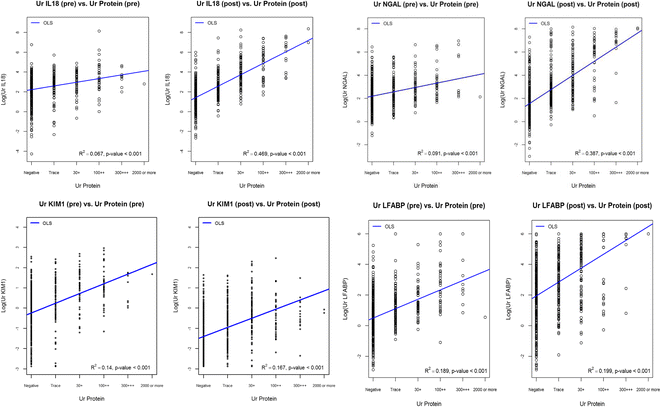Urinalysis findings and urinary kidney injury biomarker concentrations
- PMID: 28683730
- PMCID: PMC5499057
- DOI: 10.1186/s12882-017-0629-z
Urinalysis findings and urinary kidney injury biomarker concentrations
Abstract
Introduction: Urinary biomarkers of kidney injury are presumed to reflect renal tubular damage. However, their concentrations may be influenced by other factors, such as hematuria or pyuria. We sought to examine what non-injury related urinalysis factors are associated with urinary biomarker levels.
Methods: We examined 714 adults who underwent cardiac surgery in the TRIBE-AKI cohort that did not experience post-operative clinical AKI (patients with serum creatinine change of ≥ 20% were excluded). We examined the association between urinalysis findings and the pre- and first post-operative urinary concentrations of 4 urinary biomarkers: neutrophil gelatinase-associated lipocalin (NGAL), interleukin-18 (IL-18), kidney injury molecule-1 (KIM-1), and liver fatty acid binding protein (L-FABP).
Results: The presence of leukocyte esterase and nitrites on urinalysis was associated with increased urinary NGAL (R2 0.16, p < 0.001 and R2 0.07, p < 0.001, respectively) in pre-operative samples. Hematuria was associated with increased levels of all 4 biomarkers, with a much stronger association seen in post-operative samples (R2 between 0.02 and 0.21). Dipstick proteinuria concentrations correlated with levels of all 4 urinary biomarkers in pre-operative and post-operative samples (R2 between 0.113 and 0.194 in pre-operative and between 0.122 and 0.322 in post-operative samples). Adjusting the AUC of post-operative AKI for dipstick proteinuria lowered the AUC for all 4 biomarkers at the pre-operative time point and for 2 of the 4 biomarkers at the post-operative time point.
Conclusions: Several factors available through urine dipstick testing are associated with increased urinary biomarker concentrations that are independent of clinical kidney injury. Future studies should explore the impact of these factors on the prognostic and diagnostic performance of these AKI biomarkers.
Keywords: Acute kidney injury; Biomarkers; Urinalysis; Urine dipstick; Variability.
Conflict of interest statement
Ethics approval and consent to participate
The Yale University Institutional Review Board approved this study. Every participant provided a written, informed consent to be involved in the study.
Consent for publication
Not applicable.
Competing interests
Girish N Nadkarni is a member of the editorial board of BMC Nephrology.
Publisher’s Note
Springer Nature remains neutral with regard to jurisdictional claims in published maps and institutional affiliations.
Figures




References
-
- Ho J, Tangri N, Komenda P, Kaushal A, Sood M, Brar R, et al. Urinary, plasma, and serum biomarkers’ utility for predicting acute kidney injury associated with cardiac surgery in adults: a meta-analysis. Am J Kidney Dis Off J Natl Kidney Found. 2015;66:993–1005. doi: 10.1053/j.ajkd.2015.06.018. - DOI - PubMed
Publication types
MeSH terms
Substances
Grants and funding
LinkOut - more resources
Full Text Sources
Other Literature Sources
Medical
Miscellaneous

